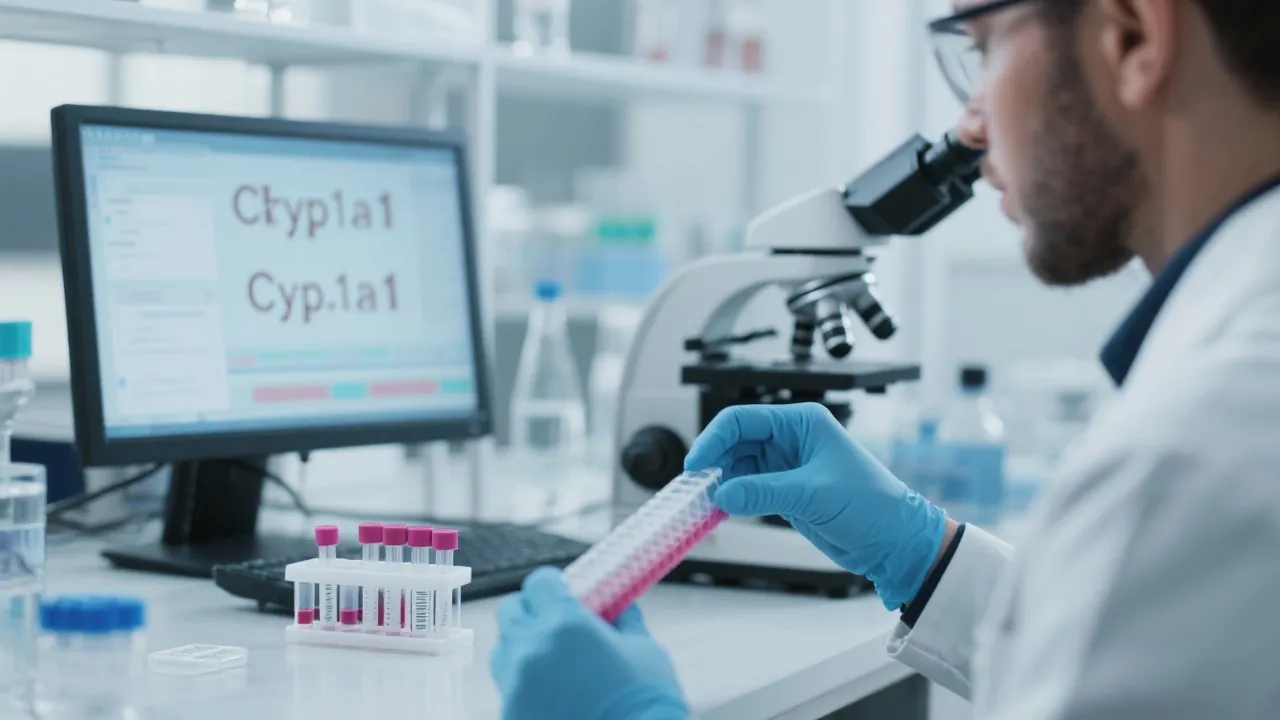Understanding the Cyp1a1 Assay
The Cyp1a1 assay is a critical tool in biochemistry for studying the enzyme CYP1A1's involvement in metabolic processes. Primarily utilized in pharmacology and toxicology, this assay helps determine the enzyme's activity, offering insights into how substances are metabolized in the body. It serves as an invaluable aid in developing new drugs and understanding environmental toxins.

Introduction to the Cyp1a1 Assay
The Cyp1a1 assay holds a pivotal role in modern biochemistry and pharmacology as it allows researchers to evaluate the activity of CYP1A1 enzymes in various biological systems. These enzymes are integral to the metabolic pathways of substances introduced into the body, including pharmacological compounds and environmental toxins. Understanding CYP1A1 function not only aids in drug metabolism studies but also provides insights into how various compounds are processed within the body, which can lead to enhanced safety profiles in drug development and regulatory assessments of environmental chemicals.
Importance of the Cyp1a1 Assay
The enzyme CYP1A1 is part of the cytochrome P450 family, which is responsible for the metabolic breakdown of many drugs and endogenous substrates. The activity of CYP1A1 is particularly notable when considering its involvement with procarcinogenic compounds, which can be converted into harmful metabolites through its catalytic action. Recognizing how CYP1A1 functions can aid in the prediction of drug interactions and potential toxic effects of chemicals at the cellular level. Therefore, the Cyp1a1 assay becomes indispensable in both drug development and environmental health research. Its capability to inform chemical safety and therapeutic index makes it a vital tool in pharmacokinetic studies aimed at optimizing drug development processes.
How the Cyp1a1 Assay Works
The Cyp1a1 assay operates by measuring the enzyme activity through the introduction of substrates that are specifically metabolized by CYP1A1. Observations are typically made via increased fluorescence or colorimetric changes as the substrates are converted. For example, compounds such as 7-ethoxyresorufin, when metabolized by CYP1A1, produce a fluorescent signal that can be quantified, allowing researchers to assess the enzyme's activity with precision. This process helps ascertain enzyme kinetics, including parameters like maximum velocity (Vmax) and the Michaelis-Menten constant (Km), as well as evaluating the potency of induction or inhibition caused by test compounds, which is crucial for understanding potential interactions and toxicities.
Applications of the Cyp1a1 Assay
The assay's applications are vast, ranging from drug development to environmental toxicology. In drug development, it assists scientists in understanding drug metabolism and potential adverse interactions. This is particularly relevant in the early stages of drug design, where the metabolic pathways of candidate compounds are assessed to predict their behavior in humans or other biological systems. In environmental toxicology, the assay is used to study the effects of pollutants like polycyclic aromatic hydrocarbons (PAHs) and dioxins, which are known to induce CYP1A1 activity. Furthermore, the assay provides critical information on how environmental contaminants can influence human health, particularly regarding cancer risk associated with agent exposure.
Steps Involved in Conducting a Cyp1a1 Assay
Below is a step-by-step guide for conducting a Cyp1a1 assay. This detailed protocol can serve as a foundation for researchers to optimize their procedures based on specific needs:
- Prepare standard solutions and control samples: Establish baseline enzyme activity by preparing control samples and standard solutions with known concentrations of CYP1A1 substrates.
- Introduce substrates specific to CYP1A1: Add substrates, such as 7-ethoxyresorufin, to your experimental samples. Ensure that the substrate concentration is within an optimal range to facilitate effective enzyme-substrate interaction.
- Measure the reaction: Employ fluorescence detection methods or spectrophotometric means to track the conversion of substrates into products, monitoring changes in fluorescence intensity or absorbance at specific wavelengths.
- Analyze data: Using appropriate software or analytical techniques, determine enzyme activity, calculating rates of reaction, and comparing them against control samples to assess metabolic implications.
Comparison Table of Cyp1a1 Assay Variants
| Assay Variant | Description | Sensitivity |
|---|---|---|
| Fluorometric Assay | Uses fluorescence detection to measure enzyme activity, allowing for high sensitivity and specificity. | Medium to High |
| Colorimetric Assay | Relies on color change for enzyme activity detection, typically involving a chromogenic reaction that can be spectrophotometrically measured. | Medium |
| Radioactive Assay | Utilizes radioactive labeling for tracking substrate metabolism, providing high sensitivity but requiring careful handling and disposal of radioactive materials. | High |
| Cell-Based Assay | Involves using live cells to measure CYP1A1 enzyme activity, typically providing a more physiologically relevant environment. | Medium |
| In Vitro and In Vivo Assays | Integrate multiple stages of experimentation, where in vivo results can be validated by comparing them to in vitro findings, enhancing the reliability of conclusions drawn from studies. | Varies |
Conditions & Requirements
For optimal execution of a Cyp1a1 assay, laboratories must maintain controlled environments to ensure enzyme stability and accurate results. This includes maintaining appropriate pH levels (typically between 7.4-7.6 for biological assays), temperatures (often 37°C for mammalian systems), and the presence of necessary cofactors such as NADPH, which is essential for the catalytic cycles of cytochrome P450 enzymes. Additionally, the purity of reagents and the quality of biological samples can significantly influence outcomes, necessitating stringent preparation and handling protocols. Researchers should also routinely calibrate their equipment to ensure precise measurements, particularly when utilizing fluorescence or other detection methods, as the accuracy of readings is vital for interpreting results.
FAQs
What factors can affect CYP1A1 activity?
Factors such as genetic polymorphisms, diet, and exposure to inducers or inhibitors can significantly influence CYP1A1 activity. For instance, consumption of cruciferous vegetables has been shown to induce CYP1A1, while certain medications, such as fluvoxamine, inhibit its activity, underscoring the complexity of enzyme regulation in diverse biological contexts.
Why is CYP1A1 important in pharmacology?
CYP1A1 plays a crucial role in the metabolic processing of drugs, impacting efficacy, safety, and potential side effects. For example, variations in CYP1A1 activity can alter the therapeutic effects of medications like carbamazepine or the toxicity of certain chemotherapeutic agents, making it essential for personalized medicine approaches and optimizing drug therapy in clinical settings.
How does environmental exposure alter CYP1A1 activity?
Exposure to certain environmental toxins can lead to increased expression and activity of CYP1A1, potentially leading to the expedited breakdown of drugs and chemicals. For example, persistent exposure to polycyclic aromatic hydrocarbons from polluted air or smoke can induce CYP1A1, heightening susceptibility to drug-drug interactions and could exacerbate toxic responses to simultaneously administered medications.
Future Directions in Cyp1a1 Assay Research
Recent advances in technology and research methodologies have opened new avenues for exploring CYP1A1 activity through the Cyp1a1 assay. Innovations such as high-throughput screening and the development of biosensors promise to enhance the assay's efficiency and throughput. By automating processes or integrating microfluidic technologies, researchers can conduct assays with greater precision and speed, significantly reducing the time and resources required for metabolic studies.
Furthermore, elucidating the regulatory mechanisms governing CYP1A1 expression will be crucial in understanding its role in various diseases, particularly cancer. As we identify novel regulatory pathways and biomarkers linked to CYP1A1 function, researchers might develop targeted therapies aimed at modulating its activity for better therapeutic outcomes. The potential integration of genomics and metabolomics into the Cyp1a1 assay paradigm stands to provide deeper insights into the individual variability in drug metabolism, paving the way for tailored exposure assessments in both pharmacological and ecological contexts.
Conclusion
The Cyp1a1 assay remains a cornerstone analytical tool in biological research, offering broad applications in understanding drug metabolism and environmental influences on enzyme activity. Its role in developing safe and effective pharmaceuticals and assessing environmental risks is invaluable. As the scientific community continues to explore the complexities of CYP1A1 in various physiological and pathological contexts, it is clear that refining and expanding the capabilities of the Cyp1a1 assay will foster significant advancements in both health and environmental sciences. Through ongoing research and the incorporation of innovative technologies, the full potential of understanding CYP1A1 and its implications in drug metabolism and environmental interaction can truly be realized, ultimately contributing to better therapeutic strategies and improved public health outcomes.





